|
NEED A GOOD HOLIDAY GIFT?
HOW ABOUT A NICE FIRE CALENDAR?NOVEMBER 06 -- AGNESS, OR: If you need a holiday gift for someone (yourself, perhaps?) you can't do much better than this for ten bucks.
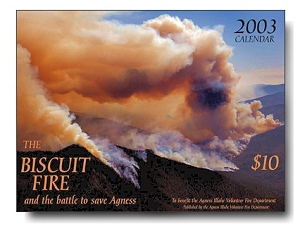 The Agness-Illahe Volunteer Fire Department has produced a 2003 calendar -- The Biscuit Fire ... and the battle to save Agness -- with photos of the Biscuit Fire, Oregon's largest and the most expensive fire in U.S. history. The Agness-Illahe Volunteer Fire Department has produced a 2003 calendar -- The Biscuit Fire ... and the battle to save Agness -- with photos of the Biscuit Fire, Oregon's largest and the most expensive fire in U.S. history.
The calendar is 12 x 9 inches folded, and it opens to 12 x 18 inches. It's 28 pages long, with 13 full-color images.
The Biscuit Fire burned nearly 500,000 acres in southwestern Oregon and northern California, and it threatened a number of communities, including the Agness-Illahe area.
These calendars are available for only $10 each, and proceeds benefit the Volunteer Fire Department in Agness. For a limited time, order five calendars and get a sixth one free. Shipping is included, and there's no sales tax in Oregon. Get yours now at www.biscuitcalendar.com before they're gone!
 THE MONSTER IN THE WOODSNOVEMBER 04 -- PORTLAND, OR: The Oregonian has produced a special don't-miss three-part series on the Biscuit Fire called "The Monster in the Woods." The series is primarily the result of considerable time spent in the field by reporter Beth Quinn, though reporter Alex Pulaski and researchers Lynne Palombo and Kathleen Blythe of the Oregonian staff also contributed. Part one of the series ran in yesterday's paper; part two is online today and part three will run tomorrow. The online version includes some serious graphics and outstanding photo galleries (not all from the Biscuit Fire). It's a series well worth reading.
 FIREFIGHTER'S ARSON CONVICTION UPHELD ON APPEALNOVEMBER 04 -- ROSEBURG, OR: The Oregon Court of Appeals last week upheld the conviction of a former Forest Service firefighter for setting a series of fires on the Umpqua National Forest during the summer of 1998. The News-Review reported that the court ruled that Forest Service officials did nothing improper when they surreptitiously attached a radio transmitter underneath Tamera Louise Meredith's agency-issued pickup to track her whereabouts after she became a suspect.
The day after the transmitter was installed, investigators saw Meredith get out of the truck; a fire started in that spot, and after a six-week trial Meredith was sentenced to more than three years in prison. She was convicted of two counts of first-degree arson, but was acquitted of 31 additional charges stemming from the fires. In her appeal, Meredith contended that the use of the transmitter constituted an invasion of privacy, that tracking the vehicle amounted to a warrantless search. The Court of Appeals disagreed.
"The actions observed by the authorities from the air included defendant getting out of her employer's pickup in a 'fairly large grassy or open area,' crouching down momentarily, getting back into the vehicle, and leaving that location. Any citizen standing in or near that location or flying overhead could have observed defendant's actions," wrote Justice Walter Edmonds.
 DFPA LOOKING INTO SUSPICIOUS FIRESNOVEMBER 04 -- ROSEBURG, OR: A series of suspicious fires took off on the hills southeast of Roseburg Halloween night, burning about 45 acres in the Dawson Canyon area, according to the Roseburg News-Review.
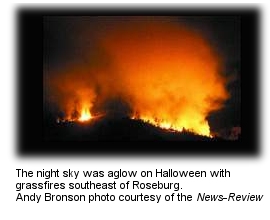 The Douglas Forest Protective Association said the fires were on hilltops east of the Southgate shopping area. The Douglas Forest Protective Association said the fires were on hilltops east of the Southgate shopping area.
"We're treating it as a suspicious fire," said the DFPA's Tom Fields. "And just because we're calling it a suspicious fire doesn't mean we're calling it arson."
Fields said November is typically the end of fire season in the area.
"But this is an unusual year due to the lack of rainfall and the fact that the grass and the trees and the brush are all really dry." He said the fires illustrated just how well vegetation can still burn, even this late in the year, under dry conditions.
The DFPA has cautioned residents that months of dry weather, combined with the high temperatures of summer, have created a tinderbox situation in Douglas County -- a situation that will not change until there is significant rainfall. More information is available online from DFPA and Douglas County Fire District #2.
 MISSIONARY RIDGE FIRE: REDEFINING DEFENSIBLE SPACENOVEMBER 04 -- DURANGO, CO: Is the Missionary Ridge Fire out? No one knows.
Ask the U.S. Forest Service. "I don't think we know," said Pam Wilson, public affairs specialist on the San Juan National Forest. Plenty is known about the Missionary Ridge Fire, according to the Durango Herald. The fire started June 9, was 99 percent contained by July 16, declared controlled on August 7, burned 70,485 acres, and ran up a suppression tab of $40.8 million. But the statistics collapse when it comes to when the fire died -- if it is dead. 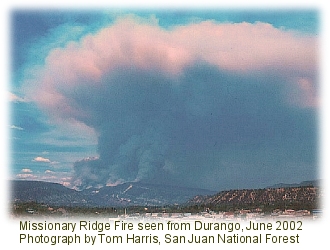 "I don't think there's any way we could give you any sort of definitive date," Wilson said. "There's a possibility that there's still some stuff smoldering. We may see some smoke next spring." "I don't think there's any way we could give you any sort of definitive date," Wilson said. "There's a possibility that there's still some stuff smoldering. We may see some smoke next spring."
The fire may be burning in roots underground, and it might do this all the way through the winter: fire under snow. In the spring, it might seem to miraculously come back to life. "We know there's some pockets of unburned fuel sitting in the interior of that fire near severely burned areas," explained Wilson.
The end of the fire is as much a puzzle as its beginning. Fire managers agree that it started with a spark, but no one knows exactly how or where. "They were never able to determine the exact cause," said Wilson. "The last I heard, the investigator's report was going to say that we're sure it was human-caused, but of an undetermined nature."
One of the factors accounting for the relatively high suppression cost on the Missionary Ridge Fire was the interface. The huge level of structure protection was forced by the number of homes pushed into the woods in La Plata County. Fire managers assigned hundreds of firefighters and dozens of engines to structure protection.
"It almost redefines wildland/urban interface," said Wilson. "It changes the whole definition of what you need to do in terms of making the forest more defensible against fire."
Because the fire spotted new fires miles ahead of the fire's front lines every time its daily plume collapsed, it also made previous definitions of defensible space around subdivisions obsolete. "A mile from a home is not necessarily enough anymore," Wilson said.
 INQUIRY DEMANDED ON AUSTRALIAN FIRESNOVEMBER 03 -- WAUCHOPE, NSW: The New South Wales Shadow Minister for Emergency Services and Member for Oxley, Andrew Stoner, has demanded answers in relation to bushfires on the mid north coast. The Hastings Gazette reported that Stoner wanted an inquiry on bushfires at Bago, Blackmans Point, The Hatch, and the northshore of Port Macquarie.
"Questions the community are demanding include how did these fires start, on whose land did they start, and when was the last time that hazard reduction in these areas was undertaken," said Stoner. "In State Parliament this week I will be seeking answers as to what action does the government intend to take in relation to those responsible for the fires and for the lack of appropriate hazard reduction measures."
Residents have been evacuated in the path of bushfires with extreme weather conditions, and Stoner said hazard reduction measures and preparedness were falling short of community expectations. "The Labor Government is clearly under-prepared for the severe bushfire season that we are experiencing on the mid north coast," he said, adding that Rural Fire Service Koperberg has called for urgent estimates of bushfire hazard reduction work.
"Obviously there are still a great many areas including urban/bushland interface full of hazardous flammable material, as shown by the Engadine fire which started on State-owned land which had not undergone controlled burning for many years," said Stoner. "It's clear that they simply don't know how much of the State's forests have been hazard-reduced, and indications are that a lot hasn't."
 FEINSTEIN BLAMES SIERRA CLUB FOR BLOCKING WILDFIRE BILLNOVEMBER 02 -- LAKE TAHOE, CA: Senator Dianne Feinstein of California blames the Sierra Club for Congress' failure to pass legislation last month that would have streamlined the process for completing fuels reduction projects. But according to an Associated Press report in the Reno Gazette-Journal, Sierra Club President Carl Pope says Republican leaders are responsible, and a timber industry leader blames Senate Majority Leader Tom Daschle of South Dakota.
All sides agree it's unlikely that Congress will reach consensus to reduce the threat of fires that have burned an estimated 6.5 million acres across the nation this year.
"You have a very polarized community when it comes to fire and how they view fire," Feinstein said. "The Sierra Club roasted me."
Feinstein said she'll attempt to build support for an emergency program she hopes to develop with Sen. Ron Wyden of Oregon and Republicans on the Senate Energy and Natural Resources Committee. She was close to securing a bipartisan agreement with Sen. Larry Craig of Idaho, an agreement that would have allowed fuels reductions on about 7 million acres. "I think the Sierra Club did it in, to be honest with you," she said at an environmental conference last week at Lake Tahoe. "There was just real opposition." She said said the Sierra Club made it impossible for her to gather the support she needed among Democrats to cut off debate and force a vote.
Sen. Craig, who chairs the Senate subcommittee on forests and public lands, offers a similar account. "The Dianne Feinsteins of this world have every reason to be frustrated and angry," he said. "I think she felt herself a friend of that organization only to have them bite her as hard as they did."
 ODF ISSUES WILDFIRE ALERTNOVEMBER 01 -- SALEM, OR: KATU-TV reported today that a wildfire alert was issued by the Oregon Department of Forestry; several small fires are burning around Oregon. One is in Central Point, where a 25-acre fire is burning south of Rogue River. A fast-moving grass fire is burning in the city of Ashland, and another fire is reported northeast of Grants Pass.
Firefighters say freezing temperatures have drawn more moisture out of already drier-than-normal vegetation. Fire officials say they are already two weeks past the average fire season ending date. ODF is urging residents to be aware of the threat and to use caution in any outdoor activity that may ignite a fire. State law requires ODF to collect fire suppression costs from individuals who start fires willfully, maliciously, or through negligence.
 FIRE IN THE SANTA CRUZ MOUNTAINSNOVEMBER 01 -- LOS GATOS, CA: A wildfire near Los Gatos and Lexington Reservoir grew to about 25 acres last night; officials said the fire started in a mobile home around 7 p.m. The Sacramento Bee reported that the mobile home was burned and 15 or 20 other structures were threatened. The fire was burning in heavy brush and very steep terrain; about 120 firefighters were on the fire. They said the fire was spreading slowly with cool weather and minimal wind.
The Los Gatos Weekly Times reported in February of this year on a series of conflicts related to fire management in the area. Lack of funding, boundary disputes, and the fire helicopter's flight path were sources of ongoing problems for the county and for fire managers. Santa Clara County in January approved a proposal to build two luxury homes near Lexington Reservoir, directly beneath the fire helicopter's flight path, but the hmeowners had to agree in writing that CDF helicopter operations generate noise and dust and could constitute an annoyance.
The CDF station and helicopter operations have been a major resource in the county; the 1985 Lexington Fire burned 13,000 acres and 42 buildings when the helicopter was out of commission. By contrast, in the 1997 Cats Fire, the helicopter was instrumental in limiting the damage to six acres and six buildings.
 PARADISE PINES RECEIVES $100,000 FOR FUELS REDUCTIONOCTOBER 30 -- MAGALIA, CA: The Paradise Pines Property Owners Association has a hundred grand in the bank, and it'll fund a fire hazard reduction program around homes at Paradise Pines. The Sacramento Regional Foundation awarded the grant as part of its Community-Based Wildfire Prevention Program; the Foundation administers this multi-million-dollar grant program with a number of private and public agencies to promote fire prevention throughout California.
Don Steele, who coordinated efforts for a sheltered fuel break around Magalia, said work will begin in the Pines by early next year.
"The brush is very dense and the work will have to be done by hand," said PPOA manager Tyler Miller.
The Chico Enterprise-Record reported that the work will be done by the California Conservation Corps in Magalia. The property to be cleared is within an existing 500-acre greenbelt area around the community. In some cases, the new firebreaks will connect with the existing breaks completed last year.
Miller said $26,000 more will be awarded in a Farm Bureau grant and $8,000 more will be funded by the Butte County Fire Safe Council. The project needs volunteer managers for the parcels to be cleared; call (530)873-1114 for more information.
 INVESTIGATION REPORT ON ENGINE ROLLOVER RELEASEDOCTOBER 30 -- YREKA, CA: A lack of experience and inadequate rest may have contributed to the deaths of three firefighters on the Stanza Fire in July when their engine rolled off a mountain road.
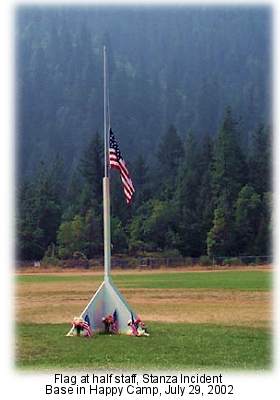 The report, released yesterday, says the engine's driver, Heather DePaolo, was on shift for 24 hours the day before the crash. The report, released yesterday, says the engine's driver, Heather DePaolo, was on shift for 24 hours the day before the crash.
She had not met the required number of hours of rest prior to the shift on which the rollover occurred.
The Redding Record-Searchlight reported that DePaolo, 29, had "minimal" experience driving the engine. She was being trained on the job as an engine operator and had a driver's permit, but no license. Acting Capt. Steven Oustad, 51, who was also killed in the crash, made the decision to allow her to drive.
Also killed in the rollover was 19-year-old John Self; Alex Glover, 19, and Ryan Smith, 20, survived the crash after the engine rolled over 1,000 feet down a steep slope in the dark.
All of the firefighters were wearing seatbelts, but the three who died were ejected as the engine rolled. The survivors crawled out of the wreckage at the bottom of the ravine.
"There's certainly information in the report we want everyone to see," said Brian Harris with the Klamath National Forest. "Hopefully the intent is that accidents like this don't take place in the future."
The Klamath has a memorial page online.
 FOREST SERVICE LOSING BEETLE BATTLEOCTOBER 29 -- LAKE ARROWHEAD, CA: Widespread damage to trees on the San Bernardino National Forest caused by bark beetles has combined with several years of drought to create a serious fire danger on the forest, and the Forest Service has beefed up fire resources because of it. But fuels reduction is not the only answer to the fire danger.
"Cutting all dead trees is not the solution to the bark beetle epidemic," says San Bernardino National Forest Supervisor Gene Zimmerman. "The answer is that we need to transition to a healthy forest overall." Zimmerman said the severe drought conditions for the last four years have stressed trees on the forest, which now has large areas of standing dead trees.
Forest personnel recognize the need for immediate action in fuels reduction, and Congressman Jerry Lewis has been asked to help secure $15 million in additional funding for the San Bernardino.
The 670,284-acre forest attracts more visitors each year than any other national forest, according to a report by the Lake Arrowhead Mountain News, and personnel are working to reduce fire hazards near mountain communities. Zimmerman said crews have been working on urban protection projects for 15 years, and the agency has acquired additional firefighting resources. "We recently added two engines, another hotshot crew, and three fire prevention technicians to our firefighting team," said District Ranger Allison Stewart. "We're also removing brush and thinning trees in many areas to help prevent future fires from crossing the San Bernardino National Forest boundary and moving into communities. We are very concerned about the potential for not only wildfire but also public safety from falling dead trees."
Stewart, headquartered in Skyforest, explained that the San Bernardino is working with communities and other agencies, including CDF, San Bernardino County Fire, Crest Forest Fire Department, and the Running Springs Fire Department.
Many of the federal firefighters currently available, though, are seasonal hires, and when their 1,039 contract hours are exhausted, they'll be off duty. "We'll have to let them go," said Stewart, "unless the Office of Personnel Management in Washington provides some flexibility for stressed areas like ours."
"People just don't realize how dry we are in the San Bernardino National Forest," said Fire Prevention Technician Greg Crawford. "The wood is drier than wood available at a lumber yard. We've never seen a drought like this. We just haven't."
 "FIRE ON THE MOUNTAIN" PREMIERES TONIGHTOCTOBER 28 -- MISSOULA, MT: "In the history of wildland fire, South Canyon is one of the landmarks," says John Maclean, who spent five years investigating and writing the book Fire on the Mountain: The True Story of the South Canyon Fire. "It is not some ephemeral thing that no one will remember 25 years later," he says. "This story -- and the feel of this story -- is forever. People still cry about this fire, and I think they always will."
 Earlier this month, Maclean joined producers from the History Channel and Lone Wolf Pictures in hosting an advance screening of the new "docu-movie" based on his book. There have been other films about the South Canyon Fire (and the History Channel did an earlier feature on Mann Gulch), but Maclean was never impressed much with anything that's aired on the South Canyon Fire. Till now. Earlier this month, Maclean joined producers from the History Channel and Lone Wolf Pictures in hosting an advance screening of the new "docu-movie" based on his book. There have been other films about the South Canyon Fire (and the History Channel did an earlier feature on Mann Gulch), but Maclean was never impressed much with anything that's aired on the South Canyon Fire. Till now.
From the beginning, he said, the History Channel's proposal felt right. "They understood that a story has to have a past to be really good. You don't just make a thrill-a-minute movie. You need the history."
The film is a combination of traditional documentary-style footage -- firefighters and families telling the story of the South Canyon Fire -- and re-creations of events, particularly of the scene on Storm King Mountain the afternoon of the blowup.
The film will be aired nationally at 9 p.m. (8 central) tonight on the History Channel.
Maclean's second book on fire will be out next spring. Henry Holt and Co. will publish a collection of fire stories written by Maclean, including a profile of Bob Sallee, one of three smokejumpers who survived the Mann Gulch blowup. The book will also include a concise history of wildland firefighting, and stories on the Sadler Fire in Nevada and the Rattlesnake Fire on the Mendocino National Forest.
 COUNTY DEBATES SUING HOMEOWNERS WHERE CROY FIRE STARTEDOCTOBER 28 -- SAN JOSE, CA: Santa Clara County supervisors will meet today in closed session to discuss filing a lawsuit against the owners of the solar power system that allegedly ignited the Croy Fire in September.
Fire investigators with CDF determined that the fire started near a single-wide trailer near Uvas Canyon County Park; the fire was reported at 1:50 p.m. on September 23. A battalion chief, two airplanes, a helicopter, and three engines were dispatched within 38 seconds; the helicopter arrived at 2:03 p.m., followed within eight minutes by the airtankers. Engines arrived at 2:39 p.m.
Despite the response, the fire burned 3,127 acres. It destroyed 31 homes and 15 outbuildings, and 65 homes were confirmed saved. Thirteen minor injuries were reported, and 1,917 firefighters worked on the fire. Suppression costs ran $7.5 million.
According to a report by The Mercury-News, the residents who owned the solar power system did not have a permit for it, and a permit is required by law. The county could therefore sue to recover expenses for suppression costs and to help other residents who lost their homes.
Even if the solar power system's owners lost everything they owned, the county could still sue on principle. Officials say that building codes and ordinances are set up to protect everyone's health and safety, and they want people to adhere to them. At the same time, they admit they lack the manpower to go door-to-door checking for compliance with building codes.
 NORTHERN CALIFORNIA RxFIRE PLANNEDOCTOBER 27 -- REDDING, CA: Fire season segues into prescribed burn season next week as national parks and national forests plan prescribed fires to reduce forest fuel loads. The first and largest project begins tomorrow at Whiskeytown National Recreation Area west of Redding, where the National Park Service will burn 312 acres over several days. The burn is part of a plan to reduce the wildfire threat to Shasta and west Redding, Park Superintendent Jim Milestone told the Redding Record-Searchlight.
The Forest Service has lifted fire restrictions on the Shasta-Trinity National Forest and will lift them Friday on the Mendocino, but that doesn't mean fire season's over. Nine days ago Redding Fire Department crews backed by airtankers initial attacked a potentially devastating arson fire near the Country Heights subdivision.
Despite cooler temperatures and increased humidity, the north state is still dry. "Wind is our biggest concern," said Carol Jandrall with the Whiskeytown NRA.
Though fire managers are planning prescribed burns, it's still too early for other outdoor burning, said Capt. Chris Newton, CDF fire prevention officer. "We still have a burning suspension on," Newton said. "It's still very dry out."
 WHAT ARE YOU WAITING FOR??OCTOBER 27 -- DURANGO, CO: Homes were lost in the Missionary Ridge and Valley fires because homeowners ignored repeated warnings to create defensible space. Firefighters were stretched too thin to make up for what property owners should have done for themselves.
Allen Farnsworth, fire education and mitigation specialist with the San Juan National Forest, had some tough words last week for property owners at a discussion of lessons from the Missionary Ridge Fire. The Durango Herald reported that more than 200 people attended the meeting at Fort Lewis College.
Farnsworth was among the hundreds of firefighters on the Missionary Ridge Fire.
"What are you waiting for?" Farnsworth asked. "One thing that really disappointed me was the amount of effort that we put into cleaning people's yards. Every day, I'd see firefighters doing people's yard work. There were so many homes that didn't have treatments that it was just impossible to save every home." One Falls Creek subdivision home, he said, was saved simply because the property had recently been cleared.
"We could have saved a lot of homes if people would have spent a weekend cleaning up their place," he said. Farnsworth explained that fire managers are concerned that they could face an even worse fire season next year. In parts of Montezuma County, 60 percent of the piñon pines have been killed by a beetle infestation.
Farnsworth said firefighters next year won't pull any punches in their safety messages to property owners who have not made any effort to create defensible space. "Why aren't you doing these treatments?" he asked. "With a little thinning, it might have turned out a lot different."
Information on defensible space for homeowners is available from www.firewise.org and www.firefree.org and from your local fire department or fire management agency. The Southwest Colorado Fire Information Clearinghouse and the Colorado State Forest Service also have a wealth of information online.
 HAYMAN FIRE WAS OVERDUEOCTOBER 26 -- DECKERS, CO: The forest around Cheesman Reservoir was about 70 years overdue for a Hayman-size fire; that's what the Wildland Fire Leadership Council learned last week during their visit to study restoration efforts following the 138,000-acre Hayman Fire that burned this summer.
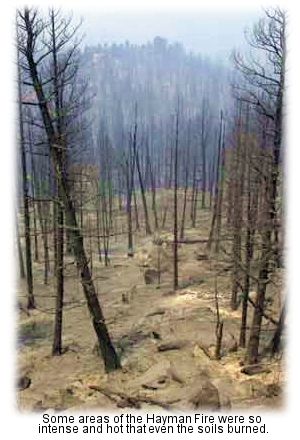 The Denver Post reported that prior to 1880, big fires burned in the area every 50 years for at least 500 years; Merrill Kaufmann, a forest ecologist who has studied the forest around Cheesman Reservoir for the past 10 years, told the Council that the last major fire occurred in 1880. The Denver Post reported that prior to 1880, big fires burned in the area every 50 years for at least 500 years; Merrill Kaufmann, a forest ecologist who has studied the forest around Cheesman Reservoir for the past 10 years, told the Council that the last major fire occurred in 1880.
He said the thinner forests of the past prevented the large treeless areas that the Hayman Fire left in its wake.
Cheesman Reservoir, Denver water officials say, is threatened by erosion from the fire. Eighty percent of Denver's drinking water runs through the watershed that feeds the reservoir.
"I've never seen an area of intense burn that has consumed the soils as well as trees," said Rebecca Watson, who is on the Council and is assistant secretary for land and minerals management for the Department of the Interior. "I think it reinforces the approach we're taking in the 10-year comprehensive forest plan."
She said the administration sees the need to speed up the appeals and litigation process for fuels reduction projects.
The Hayman Fire burned trees and and other vegetation, and in many areas it destroyed the litter layer on the forest floor. Vegetation that had shielded the soil from intense rains is gone, and plant roots no longer stabilize the soil. In many areas the fire was so hot that it created a waxy coating on the soil that causes it to repel water -- it's hydrophobic -- and increase runoff. These conditions have the potential to create another disaster: mudslides and floods. The Forest Service BAER team has contracted for three aerial operations: hydro-mulching, seeding, and aerial straw distribution; the team has updates and photos online.
 FOREST SERVICE MUST HIRE MORE LATINOSOCTOBER 26 -- SAN FRANCISCO, CA: Civil rights groups say hiring of Latino firefighters in California should be greatly increased by a settlement announced Thursday in a long-running discrimination suit. The San Francisco Chronicle reported that the Forest Service agreed, under court supervision, to work on hiring more Latinos. The goal is to match the percentage of Latinos in the state's overall workforce within three to four years, according to lawyers with the Mexican American Legal Defense and Education Fund (MALDEF)and the Employment Law Center in San Francisco. Michael Brionez, a 27-year employee who is lead plaintiff in the lawsuit, said the largest job category is "forest technician" firefighters.
"We believe it's a strong victory, because we believe the Forest Service, by agreeing to judicial oversight, is taking the first step to demonstrate its commitment to really make the changes necessary to increase its Latino work force," said Denise Hulett, a MALDEF attorney who said a similar nationwide lawsuit against the agency is pending.
Brionez said the agency had 4,747 employees in California, 410 of them Latinos. That's 8.6 percent of the agency's workforce. Latinos made up 24 percent of the state's overall workforce at the time of an earlier agreement in 1990. The earlier agreement was supposed to achieve workplace parity for Latinos in the Forest Service, but their employment rose less than 2 percent during the 1990s.
"The agency does not embrace diversity," said Brionez, who is assistant director of program development and budgeting for the Forest Service in California. The settlement requires the Forest Service to adopt "measures designed to eliminate any barriers to hiring, promotion, and retention of Hispanics." The agency also agreed to hire a full-time recruitment coordinator and to give anti-discrimination training to supervisors.
The new agreement stipulates that the Forest Service must look outside the pool of federal government workers, in which Latinos generally have been underrepresented, in its recruiting and hiring. The agency plans to improve outreach and recruitment in Latino communities, and in schools and colleges.
 NO STANDARD OF SAFETY FOR AERIAL FIREFIGHTINGOCTOBER 25 -- SACRAMENTO, CA: Too many pilots and crewmembers are losing their lives in inadequately inspected, aging aircraft -- according to the Sacramento Bee -- even in a profession where pilots are known to take enormous risks.
"This has been an area of concern for a long time," said Jim Hall, former head of the National Transportation Safety Board, who is now chairing a federal panel charged with analyzing federal aerial firefighting. "There is not a standard of safety that is equivalent to what you see for military or commercial aircraft," he said.
The last scheduled "town meeting" of the Aerial Wildland Firefighting Panel was held yesterday in Sacramento; the Forest Service and BLM charged the panel with reviewing safety, operational effectiveness, costs, sustainability and strategic guidance.
Some tanker pilots say the problem isn't the age of the aircraft in the fire fleet, but the lack of independent inspections. Although the Forest Service checks the planes, the leased aircraft aren't subject to regular inspections by the FAA or other agencies.
"The whole industry needs to have third-party inspections," said Bob Wofford, a pilot and training officer for Montana-based Neptune Aviation Service. Another problem, he said, is that the aircraft are now being flown harder and subjected to more stress than what they were designed to handle.
Several pilots yesterday described close calls. Ed Dugan, a former airtanker pilot, recalled how he encountered engine trouble while flying over an Alaska fire with a co-pilot and a load of four smokejumpers. "One of the cylinders blew off the engine and started a fire that engulfed the back of the plane," said Dugan. As the C-119 lost altitude, the jumpers and co-pilot parachuted out. Dugan stayed in the cockpit and eventually set the plane down on a flat riverbed.
Since 1980, 67 pilots and crew have died in tanker accidents, including 10 who were flying for CDF, which maintains a fleet of 52 aircraft. Through the 1980s, California followed the Forest Service system, leasing aircraft from private companies. Mike Padilla, chief of aviation for CDF, said the result was an "appalling tragedy of unacceptable fatal air tanker accidents." Then in 1990, CDF established its own program with retrofitted S-2 aircraft.
In August last year, two CDF airtankers collided over Mendocino County, killing both pilots. CDF cancelled its contract with San Joaquin Helicopters, the company that employed the two pilots, citing a number of incidents that had raised safety and performance concerns.
The panel is scheduled to provide their assessment of the program by November 15. Written comments can be emailed to [email protected] or faxed to (801)517-1021 or mailed to the Aerial Wildland Firefighting Panel at PO Box 221150,
Salt Lake City, Utah 84116.
 HULK AND PEACH DEBUT IN SYDNEYOCTOBER 24 -- SYDNEY, NSW: Firefighting helitankers Incredible Hulk and Georgia Peach made their Sydney debut yesterday, helping to extinguish a grass fire that was threatening properties on the west side of the city.
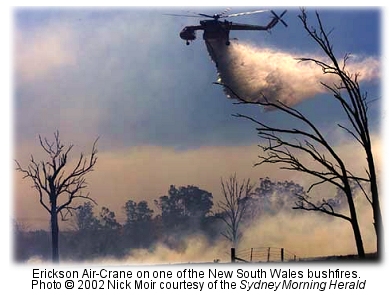 The fire in New South Wales burned 600 hectares (1483 acres), according to the Sydney Morning Herald, but was contained within two hours by 75 firefighters. The fire in New South Wales burned 600 hectares (1483 acres), according to the Sydney Morning Herald, but was contained within two hours by 75 firefighters.
The Erickson Air-Cranes, which have been used in the Hunter region and the Blue Mountains since they arrived in Australia last week, cost the NSW government $24,000 a day each (about $13,315 in U.S. dollars) for daily availability and $11,000 per hour ($6,103 U.S. dollars) in flight time for fire suppression.
NSW Rural Fire Service spokesman Cameron Wade said the tankers played a minor role in controlling yesterday's fire, but defended their use.
"Rather than worrying how much they cost, we should consider how much was saved by these houses not being destroyed," he said.
There are currently 82 fires burning across New South Wales, and more than 2000 firefighters are working on the firelines.
Temperatures of over 30ºC (86ºF) are forecast, with winds gusting up to 80kmh (50mph).
 LANE COUNTY LAW ENFORCEMENT HUNTING ARSONISTOCTOBER 24 -- SPRINGFIELD, OR: Police and fire investigators are looking for a serial arsonist who has set at least seven fires in the past 10 months. The Register-Guard reported that the arsonist has left what investigators call a "signature" at some of the fire sites, and investigators think the fires are connected. Springfield Police Chief Jerry Smith announced yesterday the formation of an arson task force; the city has established a hotline to report information about the fires.
"We have one or more determined people working together and we've got to get it stopped," said Fire Chief Dennis Murphy.
The city has had 35 arson fires since January, more than three times the number reported in a typical year. Police have arrested 28 juveniles and three adults for arson, but investigators began to consider a serial arsonist after a pair of house fires on Sunday and Monday shared striking similarities. The task force is canvassing neighborhoods and has a number of leads. Anyone with information about the Springfield serial arsonist is asked to call a new 24-hour local arson hotline at (541)736-1030.
 JACK THOMAS: NO QUICK FIXESOCTOBER 23 -- BEND, OR: Former U.S. Forest Service Chief Jack Ward Thomas said today that another "quick fix" of environmental laws to overhaul management of national forests so they are less susceptible to wildfire has a poor chance of longterm success. An Associated Press wire report said Thomas told a conference on wildfire that current environmental laws have left land management agencies without the flexibility they need to manage a changing landscape.
Thomas characterized the system of managing public lands a "SNAFU" that's been decades in the making, adding that one more quick fix could be justified by the danger of wildfire, but that quick fixes make for poor public policy. He predicted that another one like the salvage rider of 1995 would trigger a political uproar and further erode the credibility of the Forest Service and other agencies. He suggested a more careful study of the issues with a more considered approach to changing the laws that govern federal land management.
Appointed as the Forest Service's 13th Chief by President Clinton in 1994, Thomas became the first wildlife biologist to serve as head of the Forest Service. He is now the Boone and Crockett professor of wildlife conservation at the University of Montana's forestry school in Missoula. Thomas was keynote speaker at a conference, "Fire in Oregon's Forests: Assessing the Risks, Effects, and Treatment Options," sponsored by the Oregon Forest Resources Institute and the Oregon Department of Forestry.
 SOUTH AUSTRALIA CREWS BACK UP NEW SOUTH WALES FIREFIGHTERSOCTOBER 23 -- SYDNEY, NSW: More than 3000 firefighters are working to contain 65 fires across the state of New South Wales, with more hot weather and high winds predicted for the next few days. John Winter with the NSW Rural Fire Service said the worst fires were in the northern part of the state, according to a report by the Sydney Morning Herald. The fires are burning in inaccessible country, and are being fanned by winds gusting up to 70kmh (44 mph).
About 150 firefighters from South Australia are preparing to help fight fires in NSW.
South Australian Emergency Services Minister Patrick Conlon said a convoy of more than 20 emergency service vehicles would be ready to leave today, and personnel will fly to NSW tomorrow.
Sydney was blanketed by smoke and haze from fires in the Blue Mountains; Winter said the fires were burning intensely last night. Homes in the nearby township of Bucketty near the Yengo National Park were threatened before the winds shifted in the late afternoon. Fire crews also fought two fires in Sydney -- one a grass fire at Annangrove in the northwest, the other a bushfire at Belrose. In Queensland, fires forced the evacuation of 16 houses in Toowoomba; high winds and fire cut power to about 10,000 homes in the southwest part of the state.
 BUSH ADMINISTRATION TAKING COMMENTS ON PLANS TO EASE PLANNING RULESOCTOBER 22 -- WASHINGTON, DC: The Bush administration announced yesterday it will take public comment on a plan to relax environmental requirements for detailed biological surveys prior to logging federal lands in the Pacific Northwest region. The administration proposes to discontinue the "survey and manage" requirements imposed by the Northwest Forest Plan, according to an Associated Press report in the Register-Guard.
A lawsuit filed by the Douglas Timber Operators and American Forest Resources Council challenged the federal rules requiring protection of wildlife on 24 million acres of BLM and Forest Service land. The rules require study of the potential effects of logging on certain plants and animals, which can take years to complete. For example, in Oregon, federal officials in 1996 identified the Squires Peak area as a high fire risk; they began planning a fuels reduction project to thin crowded trees and dense underbrush on 24,000 acres. After six years of analysis and documentation, administrative appeals, and two lawsuits, work was allowed to begin on 430 acres of the original 24,000-acre project. When lightning ignited the Squires Peak Fire on July 13, 2002, with only a fraction of the area thinned, the fire quickly spread to 2,800 acres. The thinned area was unharmed by the fire. In unthinned areas, the fire burned intensely, killed most of the trees, sterilized soils, and destroyed the habitat of threatened spotted owls. The fire cost $2 million in suppression, and another $1 million will be needed to rehabilitate the fire area.
Environmental groups, though, do not support relaxing the rules.
"What they are trying to do is make an end-run around the environmental requirements of the Northwest Forest Plan and make it easier to log old-growth trees," said James Johnston with the Cascadia Wildlands Project.
But Rex Holloway, media relations officer with the Forest Service's regional office in Portland, said the habitat needs of species now protected by survey-and-manage rules would rely on other elements of the Northwest Forest Plan, including a sensitive species program run by the Forest Service and a special status program run by the BLM.
Written comments concerning the proposal should be sent by November 20 to SEIS for Survey and Manage, P.O. Box 2965, Portland, Oregon 97203.
 BLUE RIBBON PANEL: LAST MEETING THURSDAYOCTOBER 22 -- SACRAMENTO, CA: The last scheduled "town meeting" of the Aerial Wildland Firefighting Panel will be held Thursday, October 24 at the Hyatt Regency Sacramento at Capitol Park in Sacramento.
The panel is reviewing the federal fire agencies' aerial firefighting program; the Forest Service and BLM charged the panel with reviewing safety, operational effectiveness, costs, sustainability and strategic guidance. The panel has been collecting input at regional meetings, one of which is being held in Albuquerque today.
Thursday's meeting will run from 8:30 a.m. to 4:30 p.m. at the Hyatt Regency,
1209 L Street in Sacramento. For more information, call (916)443-1234.
Written comments can also be emailed to the panel at [email protected] or faxed to (801)517-1021 or mailed to the Aerial Wildland Firefighting Panel at PO Box 221150, Salt Lake City, Utah 84116.
 MORE HOOPA FIRESOCTOBER 22 -- HOOPA, CA: Three small fires yesterday continued the string of hundreds of fires that have plagued the region since June. The fires ranged from 1½ to 2½ acres, according to the Sacramento Bee. Firefighters were aided by helicopters, airtankers, and a bulldozer.
Almost 250 wildfires have been ignited in the Hoopa Valley this season; officials believe many were arson-caused; the worst burned more than 400 acres. There have been no arrests.
 HAPPY VALLEY VOLUNTEERS GET TRAINING CENTER FUNDEDOCTOBER 22 -- REDDING, CA: Happy Valley volunteer firefighters received a $25,000 donation yesterday to build a countywide training center. The grant from the Exchange Club of Redding will help the Happy Valley Fire Protection District build a training center that will include a building with a noncombustible lining to withstand repeated fires; that, according to the Redding Record-Searchlight, will allow firefighters to practice everything from using ladders to making rescues in confined spaces.
"Presently, there's no facility to train firefighters in Shasta County," said county Fire Warden Duane Fry. "Happy Valley has graciously offered to have all the other fire departments participate in the facility. Other departments will help come up with ideas of how best to utilize it."
The 2,080-square-foot center will be open to the county's 19 volunteer fire companies as well as the Redding and Anderson fire departments. Local fire companies have been discussing building a training center for several decades, said Larry Russell, a volunteer fire captain for Happy Valley.
"It just never would go together," Russell said. "We decided we were going to do one and we started looking for money."
The Exchange Club of Redding, a service club whose biennial Redding Air Show has produced more than $750,000 for local charities for more than 20 years, donated $25,000 toward the project. They decided to fund the facility because it will benefit residents and fire companies throughout the county.
 WALLOWA LAKE RESIDENTS CONSIDER OPTIONS TO PREVENT CATASTROPHIC FIREOCTOBER 21 -- JOSEPH, OR: The scenery of Mount Howard at Wallowa Lake is going to change, no matter what. It's not a question of if, but when Mount Howard will burn, and the fire could be devastating to homes in the Wallowa Lake area. That is part of the message presented by the Wallowa County Natural Resources Advisory Council to northeast Oregon groups and local residents.
The La Grande Observer reported that the lake community is still at risk of catastrophic fire, despite the firebreak cleared in the last two years, and despite formation of a local fire district. Bruce Dunn with the NRAC said the fuels reduction project could stop ground fires, and Forest Service FMO Nick Lunde said the firebreak can provide a safer corridor for firefighters, but the Forest Service recently asked NRAC to determine options to deal with the potentially explosive situation.
The Forest Service and the Wallowa County Commissioners want to involve county residents in town hall meetings in November and December, to learn which option the community would prefer, in order to lessen the effects of the inevitable. Mount Howard's problem is similar to that in other huge fire disasters. Decades of eliminating fire has left 40 tons per acre of dead jackstrawed trees and standing dead trees on the lower slope. Above the 6,400-foot elevation (where 80 percent of the trees are dead) there is an estimated 60 tons of dead fuel per acre.
"Those are incredible fuel loads," Lunde said. "We were lucky this year." Exacerbating the fire risk is mistletoe and an epidemic infestation of four insects -- fir engraver beetle, spruce and Douglas-fir bark beetles, and the balsam wooly adelgid that is attacking the subalpine fir. The adelgid species was introduced from Europe in the 1930s and has no natural predators here.
"Demon fuels" is what firefighters call these dead subalpine firs, Lunde said. They torch up, sending out firebrands that can rain down as far as a half mile away. A fire could thus jump from Mount Howard to Mount Joseph (with similar fuel-load problems) and surround the resort community, making a dangerous situation into which to send firefighters. An NRAC committee is studying options that might include prescribed burns and mechanical thinning. The 2,000 acres in question is Forest Service land; it's not in the Eagle Cap Wilderness, but the upper part is steep with no marketable timber to help fund a project.
"This is a complex social issue involving private property, wildland/urban interface, and watershed," said Lunde.
 MONTANA: FIRES ON THE BITTERROOTOCTOBER 21 -- HAMILTON, MT: Yes, this is October, and yes, there's a fire on the Bitterroot. It was only 30º this morning in Hamilton, but a 40-acre fire on the Bitterroot National Forest was keeping firefighters busy over the weekend.
The fire started Saturday afternoon in the Flat Creek area southwest of the West Fork Ranger District. The Missoulian reported that 35 firefighters were brought in yesterday; two helicopters were assigned to work the fire, which is burning in a remote area in light fuels. The fire was moving fast enough Saturday that a smoke column was visible from the ranger station.
The Ravalli Republic reported that the Flat Creek Fire was originally named the Sentimental Fire for a nearby creek, but it was re-named after fire managers determined it is closer to the Flat Creek area. Helicopters are dropping water on the fire and shuttling crews and equipment; firefighters were dispatched from Ronan and other areas so the Forest can maintain sufficient IA resources.
The fire was reported Saturday just hours after crews working overnight contained a five-acre fire near Hamilton. And last Wednesday firefighters contained an 18-acre fire near Kootenai Creek. The Forest Service is urging forest users to be careful with campfires, smoking, and equipment. Though it's late in the season, conditions are drier than people realize. Forest vegetation is freezing at night, according to Dixie Dies with the Bitterroot, and it's drying out enough to burn readily.
The cause of the Flat Creek Fire is under investigation; fire officials suspect it was human-caused.
 ILLEGAL BACKBURN MAY HAVE SPARKED AUSTRALIAN BUSHFIREOCTOBER 21 -- SYDNEY, NSW: Residents of New South Wales who tried their own backburning may be responsible for a bushfire that firefighters are still struggling to contain, according to a report by the Sydney Morning Herald. Two bushfires swept through the Cessnock area over the weekend, and one fire killed a man and destroyed 13 homes.
A 55-year-old man was burned to death as his car was consumed by flames on Saturday, and a fire near Kurri Kurri is believed to have started after residents carried out their own backburning.
"If we can prosecute, we will," said John Winter with the Rural Fire Service.
About 65 bushfires were burning across the state of New South Wales over the weekend; the main areas of concern were the lower Hunter region and the Blue Mountains near Bullaburra. The Hunter region was the focus of firefighting efforts, especially around Cessnock, Dungog, and Foster. Thirteen homes were lost on Saturday in the town of Abernethy, near Cessnock, and thousands of hectares of bushland were destroyed.
Three helicopters were in operation in the Hunter region, each carrying 3000 litres of water. One giant helitanker was also used. "[People believe] it's not a real fire until you have a helitanker," said Winter.
 MISSING CDF RETIREE FOUND DEADOCTOBER 20 -- PARADISE, CA: The family of John Dornan and Butte County Fire and CDF personnel are in mourning today; remains believed to be Dornan's were found yesterday afternoon near Inskip. He had been missing since last weekend.
The Chico Enterprise-Record reported that about 30 volunteers gathered at The Sport Haven at 9 a.m. yesterday to look for the missing Paradise man. The group included off-duty CDF personnel, Paradise volunteers, and Search and Rescue personnel; they combed the upper ridge, and Dornan was found by one of his sons.
Dornan, 53, retired from Butte County Fire/CDF last March after 25 years with CDF in Gridley. "He was a valued, top-notch employee," said Division Chief Henry Brachais. "Everyone, including everyone in the command center, is really sad."
Fire Capt. Mike Carr worked with Dornan for three years and had known him for more then 10 years. "He motivated me in the years that I worked with him," said Carr. "John was really motivated, even in the last years prior to retiring. He was training with the younger firefighters. John was always happy around the station. He liked to play a lot and was good at keeping morale up. I think our whole department will truly miss John."
 FIRE LEGISLATION STALLED AS SESSION ENDSOCTOBER 20 -- WASHINGTON, DC: Legislation to reduce the risk of wildfire in national forests is drawing the wrath of environmental activists, who say it will mean large-scale logging of centuries-old trees. In this campaign season, some of those environmentalists are turning on old friends who support the bill, according to an Associated Press story in the Olympian; they've denounced Rep. Peter DeFazio of Oregon and protesters turn up at his office on a regular basis.
Just as DeFazio and other House members were on the brink of a bipartisan compromise, House leaders ended the legislative session. But DeFazio and others say they'll keep trying.
"The Western United States needs a bill on wildfire -- not Democrats or Republicans," DeFazio said. "Communities are at risk. Homes are at risk. That's why we have tried to reach a compromise."
The bill's had staunch opposition from environmentalists and some Democrats, who complain about what they see as limits on public involvement. Republicans, meanwhile, are pushing to streamline fuels reduction projects by limiting appeals and judicial reviews that delay the projects. DeFazio and Miller, whose states were hard-hit by wildfire this summer, say a compromise must be reached. Drought and overgrown forests led to one of the most severe fire seasons on record, with about 6.7 million acres burned.
Leading environmental groups, including the Natural Resources Defense Council, Friends of the Earth, The Wilderness Society, and the American Lands Alliance, denounced Miller and DeFazio for trying to work out a deal with Republicans.
 AUSTRALIAN BUSHFIRES LIT BY ARSONISTOCTOBER 19 -- SYDNEY, NSW: Four fires were deliberately set along a remote country road, causing a bushfire which was still burning out of control in the Blue Mountains National Park last night, according to the Sydney Sun-Herald.
 An arsonist set the fire off about 4 miles north of Leura; the fire was headed east and could threaten the township of Bullaburra. An arsonist set the fire off about 4 miles north of Leura; the fire was headed east and could threaten the township of Bullaburra.
Late yesterday there were about 80 firefighters on the Blue Mountains fire, along with six helicopters; the RFS was expected to call in the two Erickson Air-Crane helitankers leased by the NSW government. New Zealander Grant White will join Melbourne pilot Mark Jones as well as pilots from the U.S. and Canada to operate two of the giant helicopters during the coming fire season. The aircraft are being leased for $24,000 per day each ($13,204.80 in U.S. dollars) and will be stationed at Bankstown Airport for four months.
The fire in the Blue Mountains National Park is one of 55 burning across New South Wales; firefighters were also working on outbreaks near Tenterfield, Glen Innes, and Grafton.
 RUTH LAKE FIRE COULD BE ARSON?OCTOBER 18 -- EUREKA, CA: The cause of a small fire west of Ruth Lake is under investigation, according to the Forest Service and the Eureka Times-Standard. The fire was reported early yesterday morning, and CDF and Forest Service resources responded. Despite wind and warm temperatures, the fire was contained by 3 p.m., and Rick Addey with the Forest Service said cooler evening temperatures should help with control.
"This wasn't caused by Mother Nature," he said.
CDF sent five engines, two dozers, an air attack plane, and a helicopter along with hand crews. The Forest Service had four airtankers, two crews, a dozer, a watertender, and three engines on the fire.
 PARADISE FIREFIGHTER MISSINGOCTOBER 18 -- PARADISE, CA: John Dornan has been missing since Sunday and local police fear the worst. Dornan, 53, is a retired Butte County Fire/CDF firefighter; described as six feet tall and 160 pounds with brown hair, hazel eyes, and mustache, Dornan was reported missing by his family. Law enforcement personnel said Dornan has been depressed.
The Chico Enterprise-Record reported that the Butte County Sheriff's Department conducted a helicopter search of the Feather River canyon area and Butte County Fire/CDF stations are posting flyers with Dornan's description and photo. CDF Firefighters local 2881 is organizing a search party with off-duty personnel.
"We can't sit around and do nothing," said Janet Marshall, information officer with Butte County Fire. "Firefighters are used to taking action and when it's one of our own, we're not going to sit back easily."
Dornan drives a cream and tan 1971 Ford Bronco, license plate number 021 KUU. Anyone with information should contact the Paradise Police Department at (530)872-6241.
 FIRE SEASON EXTENDED IN WASHINGTONOCTOBER 18 -- FORKS, WA: High fire danger and extended dry conditions throughout Washington's forests have resulted in the extension of the state's legal wildfire season through next Tuesday, according to the Washington Department of Natural Resources (DNR).
Interagency Incident Management Team Four has established a fire management camp near Sekiu for the Olympic Complex, a group of seven small fires burning in timber and slash and deep duff about 15 miles west of Clallam Bay. The fires are burning on private industrial forestland south of the Makah Indian Reservation, east of the Ozette Indian Reservation, and north of Lake Ozette. The largest fire is about 300 acres, and several fires are less than five acres. The cause of the fires is under investigation.
The Peninsula Daily News reported that about 400 acres had burned by Wednesday night. Fire Prevention Specialist Paul Hampton with DNR said several helicopters and about 300 firefighters were on the fire; the complex was estimated at 40 percent containment last night.
Through Tuesday, October 22, firewood cutters, woods workers, and industrial forest users are required to observe special safety precautions. The Industrial Forest Precaution Level system that regulates the use of chainsaws and other spark-emitting equipment is also extended until October 22. The DNR has information on fire danger by county online.
By law, Washington's fire season typically starts April 15 and ends October 15. Eastern Washington and the Columbia Gorge area, where most of Washington's major wildfires typically take place, are still receiving less precipitation than normal. After an already dry summer with less than half normal rainfall, September precipitation rates also fell short; the east slopes of the Cascades were at 20 percent of normal, and central Washington only 10 percent of normal.
"The Pacific Northwest typically closes the fire season with a season-ending rain event," said DNR Fire Weather Meteorologist Greg Sinnett. "This year, however, an El Niño pattern in the Pacific Ocean is deflecting storms both north and south, away from Washington. Longer range weather computer models call for below normal precipitation throughout the winter months."
For more information on the Olympic Complex fires, contact Cathy Baker, Forks fire information, at (360)374-6131.
 SECURITY REVIEWED AT AIRTANKER BASESOCTOBER 17 -- WASHINGTON, DC: The Forest Service has been reviewing security at its airtanker bases after the agency was warned earlier this year about terrorist risks connected with airtankers. The Forest Service hired an intern -- a recent law school graduate with no aviation or security experience -- to coordinate its nationwide anti-terrorism response, and fewer than a third of the airtanker bases have been inspected.
 "Some deadlines were not met in the heat of the fire season," said Tom Harbour, deputy director with USFS Fire & Aviation. "If somebody's really determined, I couldn't guarantee that one of these aircraft wouldn't be hijacked." "Some deadlines were not met in the heat of the fire season," said Tom Harbour, deputy director with USFS Fire & Aviation. "If somebody's really determined, I couldn't guarantee that one of these aircraft wouldn't be hijacked."
The Daily Camera reported that the JeffCo tanker base in Colorado is one of the 14 bases inspected. Mark Michelsen, base manager, said it received high marks. Security programs and a plan to relocate in an emergency were developed before September 11, 2001; aircraft are kept locked and lighted behind secure fencing at night and have regular police patrols.
The contracted airtankers "are vulnerable to theft and could be attractive to terrorists wishing to disperse biological or chemical weapons," according to a March report by the inspector general of the Department of Agriculture. But the Forest Service has not had the time or money to assess the threat at all 52 tanker bases, said Tim Melchert, 35, the intern assigned in August to work on aviation security.
The inspector general's report also said, "Four of the seven airtanker bases we visited generally had only a chain link fence around the compound and not all of the gates were secured." But many security measures that could be taken would conflict with the need to get tankers in the air quickly. Locking the planes in a secure hangar, for instance, would delay response time and could jeopardize homes near a fire.
Also, launching a chemical or biological attack from an airtanker could only be done by someone trained to fill the tanks on the aircraft, fly it, and operate the dispersal system. The government was concerned enough to order cropdusters grounded for several days at a time after the attacks, even at the height of the agricultural spraying season in some areas.
 LASSEN PLANS MEMORIAL SERVICE FOR FALLEN FIREFIGHTERSOCTOBER 16 -- CHESTER, CA: The Lassen National Forest invites firefighters, friends, and family to a memorial service on Saturday in honor of the three firefighters who died on the Stanza Fire on the Klamath National Forest earlier this summer: Steven Oustad, 51, of Westwood, California, Heather DePaolo, 29, of Redding, California, and John Self, 19, of Susanville, California.
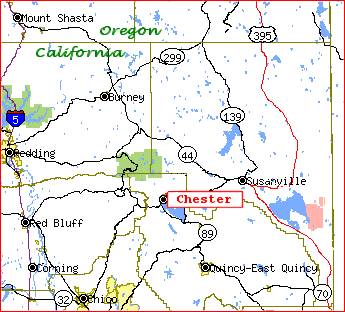 The three were killed when their Forest Service engine went off a mountain road at about 2 a.m. on July 28. The three were killed when their Forest Service engine went off a mountain road at about 2 a.m. on July 28.
The two other crewmembers who were injured -- Ryan Smith, 20, and Alex Glover, 19 -- were later released from the hospital for recuperation.
All five were crewmembers of Engine 11 from the Almanor Ranger District of the Lassen National Forest stationed in Chester.
The memorial service will be held this Saturday, October 19, at the Chester High School football field at 612 First Street in Chester.
For more information, call Leona Rodreick at (530)257-2151
 SBA DECLARES CROY FIRE SITE A DISASTER AREAOCTOBER 15 -- MORGAN HILL, CA: The U.S. Small Business Administration has declared the site of the Croy Fire a disaster area, making victims of the fire eligible for low-interest government loans. The fire burned more than 3,000 acres in the foothills of the Santa Cruz Mountains west of Morgan Hill. KCRA-TV reported that the Croy Fire was the third-largest wildfire ever in Santa Clara County; it destroyed 34 homes and damaged four others. Suppression costs ran $8.8 million and property damage is estimated at $3.5 million. The CDF site on the Croy Fire says that 65 residences were confirmed saved.
The SBA last week granted the California Office of Emergency Services' request to declare the site a disaster area so that residents would be eligible to apply for disaster loans, and the SBA opened a disaster office in Morgan Hill on Saturday. For more information call the SBA at (800)488-5323 or check their website at www.sba.gov/disaster/
 FIRE SAFE COUNCILS: PREPARING FOR THE FIRE SEASONS AHEADOCTOBER 15 -- AUBURN, CA: As the 2002 wildfire season edges toward fall, fire managers are reminding people that we're not yet out of the woods. The months of October and November have produced disastrous wildfires in many communities, particularly in California. As Mark D'Ambrogi, Auburn Fire Chief, recently wrote in the Auburn Journal, the threat is still very real and present. With the right conditions -- wind, fuels, and an ignition source -- communities such as Auburn could still experience a disastrous wildfire.
So what do fire managers recommend we do? "We prepare for the fire seasons ahead," says D'Ambrogi. "When do we do this? Now."
 D'Ambrogi urges local residents to participate in the Greater Auburn Area Fire Safe Council, a forum for local officials and citizens to identify fire safety concerns and develop long-term fire-safe planning for the community. D'Ambrogi urges local residents to participate in the Greater Auburn Area Fire Safe Council, a forum for local officials and citizens to identify fire safety concerns and develop long-term fire-safe planning for the community.
Combining the expertise, resources, and distribution channels of its members, a Fire Safe Council preserves California's natural and manmade resources by mobilizing Californians to make their homes, neighborhoods, and communities fire safe. Since its formation in April 1993, the Fire Safe Council has distributed fire prevention education materials, evaluated legislation related to fire safety, and helped other organizations with fire safety programs. There are 50 public and private organizations listed as members of the Fire Safe Council. A list of local councils in California is maintained online, and information on forming a local council is available by emailing [email protected] or checking the FSC website at www.firesafecouncil.org
The Greater Auburn Area Fire Safe Council meets on the third Thursday of each month in the City Hall Rose Room. The next scheduled meeting is Thursday, October 17, at 4 p.m.
 COLLABORATION PAYS OFF ON THE WILLAMETTEOCTOBER 14 -- DETROIT, OR: Though environmental activists in the Pacific Northwest are well known for blocking timber sales and tying up forest management projects through appeals and litigation, both Forest Service officials and environmentalists agree that a proposed timber sale near Detroit is proof that collaboration can pay off. The Salem Statesman-Journal reported that the 475-acre Windy Canyon sale on the Willamette National Forest will yield about 6.5 million board feet of timber, mostly 70-year-old Douglas-firs; the sale goes up for auction November 7.
"We feel it's a big success story," said Jeremy Hall, northwest field representative for the Oregon Natural Resources Council. "It's a win for the forests, it's a win for some of the local timber companies, and it's a win for the Forest Service to be able to get things done."
Rodney Stewart, with the Detroit Ranger District, said he and Hall have been hashing out terms of the sale since planning began in 1997. "Jeremy brought things to us that he told us quite clearly he didn't agree with," said Stewart. The sale originally included seven groves of old-growth trees, for example. That provision was dropped. Now the sale comprises thinning of trees that are mostly less than 20 inches in diameter, most of which will be removed by helicopter.
The ONRC advocates measures that mimic nature in reducing fuel loads, so as to return forests to their pre-settlement densities and fire regimes. These measures include prescribed burning, thinning of small fire-sensitive trees, removal of livestock, a let-burn policy in some areas, and less destructive firefighting techniques.
 STEHEKIN PROJECT TAKES THE FORESTS BACK 100 YEARSOCTOBER 14 -- STEHEKIN, WA: The narrow valley behind this rustic Lake Chelan community is so ripe to burn, so thick with pine, fir, and parched needles, that managers with the National Park Service are taking an unusual step: They're logging.
The Seattle Times reported that what's happening seems like a page ripped from Bush's Healthy Forests Initiative. There's growing evidence to suggest that some forests can be returned to a natural, more fire-resistant state only through burning and thinning. But much of the debate in Congress has focused solely on logging -- and whether environmental rules have made the forests prone to out-of-control fires.
"The issue is how to change the combustibility of these landscapes, so we can control the fires we want controlled," said Stephen J. Pyne, an Arizona State University professor and the author of several wildfire books. "It may mean raking up pine needles. It could mean thinning. It could mean burning. But instead of framing the issue in those terms, we went right for the political jugular -- environmental rules versus logging. The present situation is absurd. It's a blood feud."
Tod Johnson, FMO for the the North Cascades National Park, said much of the debate has missed the point; he says limits on thinning are one of the worst things that could be done, but that community trust in agency management is critical.
Near a popular trailhead west of the Stehekin boat landing is an open stand of trees. Last winter, with the valley buried in snow, a commercial logging contractor came through this 34-acre site and removed dozens of Douglas-firs. The simple explanation, Johnson said: The trees didn't belong there.
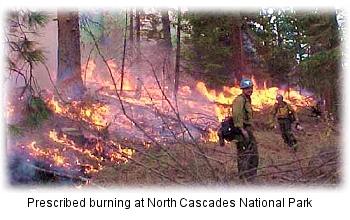 The ponderosa pine forest used to burn every five to 30 years. Small fires consumed twigs, branches, and needles. Occasional crown fires culled the pines and left grassy openings in the forest. Tree stands in the pine forests from eastern Washington to South Dakota now have 10 to 100 more trees per acre than they once did. The ponderosa pine forest used to burn every five to 30 years. Small fires consumed twigs, branches, and needles. Occasional crown fires culled the pines and left grassy openings in the forest. Tree stands in the pine forests from eastern Washington to South Dakota now have 10 to 100 more trees per acre than they once did.
"Some of these forests have changed so much they're burning outside their evolutionary capabilities," said Pyne.
In Stehekin, the forest is a lightning strike away from conflagration. Last year, the Rex Creek Fire southeast of Stehekin exploded to 54,000 acres, running nine miles in one night. In Stehekin, Park Service employees trimmed trees around homes to create firebreaks. They removed brush and piled it for removal. And they used controlled burns -- with mixed success.
"Prescribed fire wasn't working," said Andris Vezis, another fire manager. "The pole-sized and larger trees weren't dying -- we couldn't get the fire hot enough to kill them. The heat wasn't enough to mimic real fire." So the NPS proposed logging.
They held public meetings and put together environmental impact statements. Slowly, season by season, they began cutting bigger trees, while continuing with prescribed fires. They agreed to stack all the marketable timber for locals to use as firewood. Few environmentalists questioned the motives for the logging. Still, fire manager Vezis said, he was pleased that "people you'd think would be against us are actually with us; some of our strongest opponents are now some of our strongest allies."
 WET AUTUMN WEATHER IN TENNESSEE SLOWS FIRE SEASONOCTOBER 13 -- CHATTANOOGA, TN: Tennessee's wildfire season starts tomorrow, and the state's foresters are finding this year's damp woodlands as pleasing a sight as the annual colorful foliage.
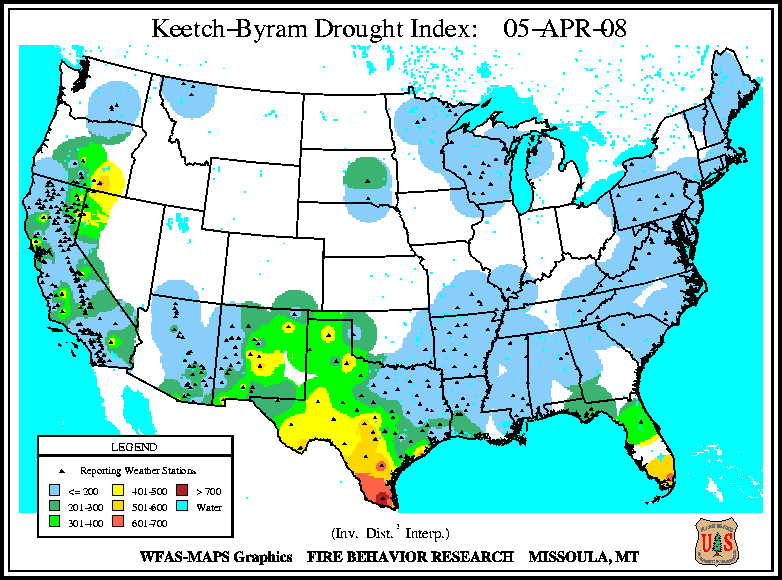 "It is looking pretty good right now," said John Kirksey, state forest protection chief. "It is looking pretty good right now," said John Kirksey, state forest protection chief.
The Tennessean reported that steady rains could mean that the upcoming fire season -- October 15 through May 15 -- will provide a break after two busy fire years.
"If these hurricanes keep moving through, maybe we'll slip under the wire here," said Robin Bible, state fire management staff forester.
In 2001, wildfires burned 70,000 acres statewide, compared with 84,435 acres that burned in 2000. So far this year, wildfires have burned only 13,837 acres in the state.
An extended drought across the Southeast has not been as severe in Tennessee.
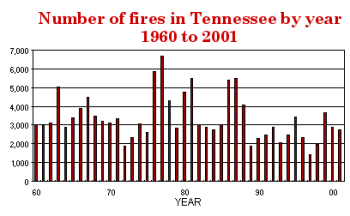 Annual rainfall accumulations are about 6 inches below normal in Chattanooga and about 6 inches above normal in Knoxville. Annual rainfall accumulations are about 6 inches below normal in Chattanooga and about 6 inches above normal in Knoxville.
But forestry folks know it's just a temporary lull.
"It is going to dry up, and it's going to get colder, and the leaves are going to fall," said Robert Rhinehart with the forestry division. "The funny thing is, if you've been in fire very long at all, if this rain stops and we've had a couple of days of pretty weather and a little bit of wind, sagebrush is going to burn."
The National Weather Service predicted drier, cooler air arriving tomorrow for several days, with the temperature dipping to the low 40s.
 RxFIRE ON THE DESCHUTES GETS AWAYOCTOBER 14 -- SISTERS, OR: Wind blew a prescribed burn on the Sisters Ranger District out of control Thursday, but the fire's now about 75 percent contained at 150 acres. Jinny Pitman with the Forest Service told the Bend Bulletin they were planning to burn about 40 acres north of Sisters and four miles east of Camp Sherman.
"We can usually catch any spot fires on flat ground, but because it was on the ridge and burned very rapidly upward, it just got out of control," said Pitman.
The RNA Fire, in the Metolius Research Natural Area on the Deschutes National Forest, burned through dry fuels. Incident Commander Daryl Davis of the Sisters Fire Department said a retardant drop on the fire helped in containment. "The retardant held down the fire until we got here," Davis said. "Now we've got the fire knocked down. It's looking great."
A burnout operation was conducted yesterday, and the fire's growth has been confined within the Research Natural Area. It's remained a low intensity fire, mostly burning underbrush and dead, downed material. The management plan for the area includes applying Minimum Impact Suppression Tactics (MIST), minimizing the impact on the landscape from fire suppression activities to protect the scenic value of the area.
"A goal of the research area is to study the effects of wildfire in natural conditions," said Lorri Heath, FMO on the Sisters portion of the Cascade Division. "We're pleased this fire has remained at a low intensity with little mortality." Visitors to the area can expect some delays and detours in the RNA area, at the junction of the 14 Road and the 900 spur, and south of Wizard Falls Fish Hatchery.
 FLAME-IN-GO FIREFIGHTERS' KIDS WON'T GET DEATH BENEFITSOCTOBER 13 -- SALT LAKE CITY, UTAH: The children of two Utah State Prison inmate firefighters, who died two years ago while fighting a fire in Tooele County, have once again been denied death benefits by the federal government.
 The Daily Herald reported that a U.S. Department of Justice administrative hearing officer has denied an appeal filed on behalf of 12-year-old Natasha Whittaker and 5-year-old Raymond Braithwaite. The Daily Herald reported that a U.S. Department of Justice administrative hearing officer has denied an appeal filed on behalf of 12-year-old Natasha Whittaker and 5-year-old Raymond Braithwaite.
Whittaker's father, Michael Todd Bishop, 27, died August 23, 2000, along with 26-year-old Rodgie Braithwaite. The two were members of the prison's Flame-In-Go inmate firefighter program overseen by Utah's Division of Forestry, Fire and State Lands.
Bishop and Braithwaite were fighting the North Stansbury Fire west of Grantsville, Utah, when they were struck by lightning and killed. Four other firefighters were seriously injured in the same lightning storm; they were examined at a hospital and released the same evening.
 Bishop's family applied for $147,000 in federal firefighter insurance benefits, and Braithwaite's family later joined them in their quest. But the government says inmates are ineligible because they cannot be classified as public safety officers. Bishop's family applied for $147,000 in federal firefighter insurance benefits, and Braithwaite's family later joined them in their quest. But the government says inmates are ineligible because they cannot be classified as public safety officers.
Bishop and Braithwaite were both federally certified firefighters and trained to NWCG standards, but the Justice Department says no prison firefighter's relatives have ever been granted benefits.
The families' attorney is filing a final appeal with the Justice Department.
The 63-page accident investigation report is online in PDF courtesy of the BLM.
 AIRTANKER CREW HONOREDOCTOBER 13 -- RENO, NV: Three crew members who died when when their airtanker crashed on a fire in June were honored yesterday at the Nevada Firefighters Memorial in Mills Park. The Reno Gazette-Journal reported that about 150 people watched as plaques in memory of pilot Steve Wass, co-pilot Craig Labare, and flight engineer Mike Davis were unveiled at the memorial. The three men went down in a C-130A after dropping on the Cannon Fire in Walker, California, 80 miles south of Reno.
Another plaque honoring Capt. Bob Marsh of Clark County's Cal-Nev-Ari Volunteer Fire Department also was dedicated. The 78-year-old Marsh died of a heart attack while responding to an October 2001 traffic accident.
The enrollment of these four brings to 50 the number of firefighters known to have died in the line of duty in Nevada since 1870. Family members of all four were present.
Two nieces and a nephew of Wass were escorted by Duane Powers of Hawkins & Powers Aviation, who owned the plane that crashed near Walker. An American flag that flew over the U.S. Capitol on August 12 in memory of the victims of last year's terrorist attacks also was used in the event.
 "WE THOUGHT IT MIGHT GO ON FOREVER"OCTOBER 11 -- LAKEWOOD, CO: Airtanker operators told a panel of aviation experts yesterday that problems with government contracts prevent the airtanker industry from modernizing the fleet and maximizing safety. The Denver Post reported that the contracts, usually signed as 3-year deals, are re-evaluated before each fire season. The cost for the Forest Service to contract 44 planes was $13 million to $15 million last year; that's far less than what's needed to maintain a strong safety program, according to Duane Powers, owner of Hawkins & Powers.
The Rocky Mountain News reported that the federal contracts don't pay enough to provide for the modern testing and maintenance essential for safety.
"Safety costs money," said Gene Powers with H&P. "If you deprive someone of funds, they will have to make cuts." He said without the assurance of multi-year agreements, contractors hesitate to perform detailed and costly inspections and upgrades.
"In the past, the Forest Service has gone for the economics in the contracts," said Tom Landon, branch chief for aviation with Region 2 of the Forest Service. "You get what you pay for. To correct this problem, the aerial program will have to pay to upgrade the equipment."
Forest Service Aviation Director Tony Kern said the contractors have a legitimate claim; the fire agencies have used the tanker services for "a very bargain price" over the years. "But it's not the government's responsibility," he said, "to put forth a plan to modernize the aircraft for the industry."
"Ironically, I believe the airtanker industry has done such a good job with old equipment for so long that we all thought it might go on forever," added Kern.
James Hall, who chairs the panel, said that while aircraft owners have a responsibility for safety, so does the federal government when the planes are used to protect public safety. "The government owes one level of responsibility for every individual it puts in harm's way," Hall said.
According to the Billings Gazette, Hall is concerned about what the government is doing to make sure the contracted airplanes are safe to fly. "In giving an assignment, it should be the government's responsibility that they have the proper piece of equipment to do that job," he said.
The panel was commissioned by the chief of the Forest Service and the director of the BLM to analyze the safety and performance of the aerial firefighting industry. The panel has scheduled meetings at Portland, Salt Lake City, Denver, Albuquerque, and Sacramento. Written comments can be submitted to the panel at the meetings or can be emailed to [email protected] or faxed to (801)517-1021 or mailed to the Aerial Wildland Firefighting Panel at PO Box 221150,
Salt Lake City, Utah 84116.
 CLEVELAND CLOSESOCTOBER 10 -- SAN DIEGO, CA: Faced with the driest conditions in recorded history, the Cleveland National Forest will close indefinitely tomorrow because of extreme fire danger.
"Fires this summer have burned with such intensity that they are almost impossible to control," said Forest Supervisor Anne Fege. "We must do everything possible to prevent additional large fires in our forest. Restricting use in remote areas during this time of extreme fire hazard will help to prevent catastrophic wildland fires."
The Sacramento Bee reported that recreational use will be restricted to developed areas where roads allow access for firefighters. No campfires will be allowed on any part of the forest. Remote camping also is prohibited. Hunting will be allowed in the Agua Tibia Wilderness and Indian Flats. The closure does not apply to private lands within the forest; highways and roads will remain open for through traffic only.
The Cleveland is the third major southern California forest to be closed in recent weeks because of fire danger. The San Bernardino was closed last week because of extreme fire conditions there. The entire 650,000-acre Angeles National Forest was closed last month after the Curve Fire there burned more than 20,000 acres and 73 structures.
Current resources on the Cleveland include three hotshot crews, 28 engines, three helicopters, and one airtanker. Additional prevention patrols will be added to supplement staffing levels. This full level of firefighter staffing is planned through Thanksgiving or until substantial rainfall occurs.

GS-7 ASSISTANT ZONE FIRE MANAGEMENT OFFICERS NEEDEDOCTOBER 08 -- SKYKOMISH, WA: The Mount Baker-Snoqualmie National Forest will be filling two positions for GS-7 Assistant Zone Fire Management Officer; one position is located in Darrington and the other position is at Skykomish. These position will be advertised under both Merit Promotion and Demo, and this is the second outreach for the positions. Duties include assisting the Zone Fire Management Officer with fire and fuels management activities. Responsibilities include preparedness, training, supervision, and direction of zone fire suppression and fuels resources, along with upkeep and maintenance of fire suppression equipment. Persons in these positions also assist the FMO in other training, situation and availability reporting, maintaining training records, scheduling training, work capacity testing, fire refresher training, fire reviews, and RAWS maintenance. Announcements for this position will be posted on the OPM website under series 0462, and an outreach notice is online in WORD format. For more information call Dave Johnson at (425)744-3510 or email him at [email protected]
 PANEL SCRUTINIZING AIRTANKERSSEPTEMBER 29 -- RENO, NV: The aging aircraft that fight wildfires under federal contract for the Forest Service have been under scrutiny before. But none of the audits or probes or letters had the impact of the horror caught by a Reno television news crew this summer when an airtanker's wings snapped off in mid-air. The video of the plane plunging to the ground in flames, killing all three men on board, transfixed television viewers nationwide.
A month after the June 17 crash near Walker, California, another airtanker crashed near Rocky Mountain National Park in Colorado, killing both crew members. An Associated Press story in the San Diego Union-Tribune reported that a newly created "blue ribbon panel" is conducting a thorough review of the agency's aerial firefighting program. The NTSB said shortly after the crashes this summer that fatigue cracks were found in the wings of both planes, and investigators are looking closely at the cracks and other safety issues to determine whether they caused the wings to fail. This month, NTSB officials said preliminary tests showed metal fatigue was not evident over the entire wing in either plane, but that crack detection techniques may have been unreliable.
Forest Service Chief Dale Bosworth has charged the new panel with reviewing "safety, operational effectiveness, costs, sustainability and strategic guidance." The panel plans to collect input at regional meetings. Besides the five remaining C-130As in the fleet, the agency also is reviewing other firefighting aircraft, including the 19 Beechcraft Barons it owns for use as lead planes.
The panel has scheduled meetings at Portland, Salt Lake City, Denver, Albuquerque, and Sacramento. Written comments can be submitted to the panel at the meetings or can be emailed to [email protected] or faxed to (801)517-1021 or mailed to the Aerial Wildland Firefighting Panel at PO Box 221150,
Salt Lake City, Utah 84116.
| 
